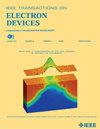Defect-Engineered Resistive Switching in van der Waal Metals
IF 2.9
2区 工程技术
Q2 ENGINEERING, ELECTRICAL & ELECTRONIC
引用次数: 0
Abstract
In this work, we demonstrated bipolar resistive switching (RS) in van der Waals metals [tantalum di-sulfide (2H-TaS2), tantalum di-selenide (2H-TaSe2)], and their heterostructures (2H-TaS2/2H-TaSe2) by engineering defects through joule heating mechanism. Localized heating is achieved by injecting current to the van der Waals metals and the induced defects were found to be mostly chalcogenide vacancies. The vacancies act as dynamic charge-trapping and de-trapping sites within the material structure, thereby inducing RS in the device. The SET/RESET process is controlled by changing the direction of the current flow, a behavior that is very similar to that of a memristor. But unlike a memristor, the reported device has a completely different architecture with no oxide or semiconducting active layer. Temperature-dependent studies revealed that the carrier transport is dominated by space-charge limited conduction and sharp switching occurs due to the voltage-driven modulation of potential barrier heights at the region containing the defects. The study offers a simple alternative to conventional two-terminal resistive switches and the potential of van der Waals metals for the advancement of memristive devices.范德华金属中的缺陷工程电阻开关
在这项研究中,我们通过焦耳加热机制,在范德瓦尔斯金属[二硫化钽(2H-TaS2)、二硒化钽(2H-TaSe2)]及其异质结构(2H-TaS2/2H-TaSe2)中,利用工程缺陷实现了双极电阻开关(RS)。通过向范德华金属注入电流实现局部加热,发现诱导的缺陷主要是钙钛矿空位。这些空位在材料结构中充当动态电荷捕获和去捕获点,从而在器件中产生 RS。通过改变电流流动方向来控制 SET/RESET 过程,这种行为与忆阻器非常相似。但与忆阻器不同的是,报告中的器件结构完全不同,没有氧化物或半导体活性层。随温度变化而变化的研究表明,载流子的传输主要受空间电荷限制传导的影响,在含有缺陷的区域,由于电压驱动的势垒高度调制,会发生急剧的切换。这项研究为传统的两端电阻开关提供了一种简单的替代方法,并为范德华金属在推动记忆器件发展方面的潜力提供了可能。
本文章由计算机程序翻译,如有差异,请以英文原文为准。
求助全文
约1分钟内获得全文
求助全文
来源期刊

IEEE Transactions on Electron Devices
工程技术-工程:电子与电气
CiteScore
5.80
自引率
16.10%
发文量
937
审稿时长
3.8 months
期刊介绍:
IEEE Transactions on Electron Devices publishes original and significant contributions relating to the theory, modeling, design, performance and reliability of electron and ion integrated circuit devices and interconnects, involving insulators, metals, organic materials, micro-plasmas, semiconductors, quantum-effect structures, vacuum devices, and emerging materials with applications in bioelectronics, biomedical electronics, computation, communications, displays, microelectromechanics, imaging, micro-actuators, nanoelectronics, optoelectronics, photovoltaics, power ICs and micro-sensors. Tutorial and review papers on these subjects are also published and occasional special issues appear to present a collection of papers which treat particular areas in more depth and breadth.
 求助内容:
求助内容: 应助结果提醒方式:
应助结果提醒方式:


